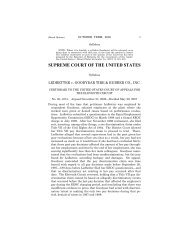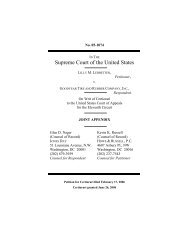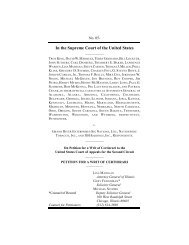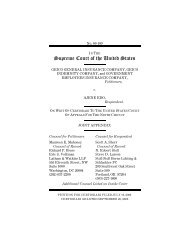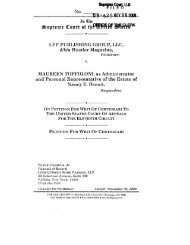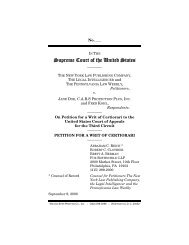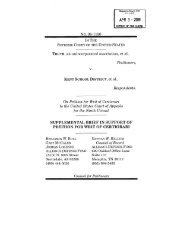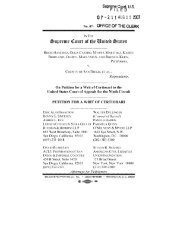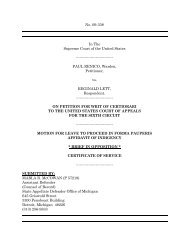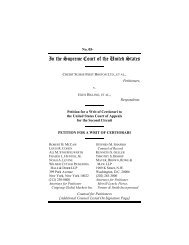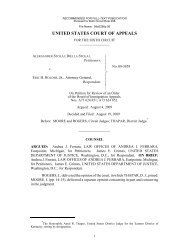Petition for certiorari - SCOTUSblog
Petition for certiorari - SCOTUSblog
Petition for certiorari - SCOTUSblog
Create successful ePaper yourself
Turn your PDF publications into a flip-book with our unique Google optimized e-Paper software.
No,<br />
IN THE<br />
~;xvp~e Court,<br />
FtLE[5<br />
0 ? " 5 9 1 001" Z 6 2007<br />
OFFICE OF THE CLERK<br />
upreme ¢£aurt a[ tl e i nite tate<br />
Luis E. Melendez-Diaz,<br />
<strong>Petition</strong>er,<br />
V.<br />
Massachusetts<br />
On <strong>Petition</strong> <strong>for</strong> a Writ of Certiorari<br />
to the Appeals Court of Massachusetts<br />
PETITION FOR A WRIT OF CERTIORARI<br />
Mary T. Rogers<br />
ATTORNEY AT LAW<br />
P.O. Box 47<br />
Salem, MA 01970<br />
Thomas C. Goldstein<br />
AKIN, GUMP, STRAUSS<br />
HAUER & FELD LLP<br />
1333 New Hampshire Ave., NW<br />
Washington, DC 20036<br />
Jeffrey L. Fisher<br />
Com~sel of Record<br />
Pamela S. Karlan<br />
STANFORD LAW SCHOOL SUPREME<br />
COURT LITIGATION CLINIC<br />
559 Nathan Abbott Way<br />
Stan<strong>for</strong>d, CA 94305<br />
(650) 724-7081<br />
Amy Howe<br />
Kevin K. Russell<br />
HOWE & RUSSELL, P.C.<br />
4607 Asbury PI., NW<br />
Washington, DC 20016<br />
October 26, 2007<br />
WILSON-EPES PRINTING Co., INC. -- (202) 789-0096 - WASHINGTON, ~). C. 20002
QUESTION PRESENTED<br />
Whether a state <strong>for</strong>ensic analyst’s laboratory<br />
report prepared <strong>for</strong> use in a criminal prosecution is<br />
"testimonial" evidence subject to the demands of the<br />
Confrontation Clause as set <strong>for</strong>th in Cr,~wfo~’d v.<br />
Wast~ingto~, 541 U.S. 36 (2004).
ii<br />
TABLE OF CONTENTS<br />
QUESTION PRESENTED .............................................i<br />
TABLE OF CONTENTS ...............................................ii<br />
TABLE OF AUTHORITIES .........................................iv<br />
PETITION FOR A WRIT OF CERTIORARI ................1<br />
OPINION BELOW .........................................................1<br />
JURISDICTION .............................................................1<br />
RELEVANT CONSTITUTIONAL AND<br />
STATUTORY PROVISIONS .........................................1<br />
INTRODUCTION ...........................................................3<br />
STATEMENT .................................................................4<br />
REASONS FOR GRANTING THE WRIT .....................9<br />
I. The Decision Below Implicates an Irreconcilable<br />
Conflict Among Federal and State<br />
Courts .....................................................................9<br />
II.<br />
The Question Presented Significantly Impacts<br />
the Administration of Criminal Justice .............. 15<br />
III. This Case Is an Excellent Vehicle <strong>for</strong> Considering<br />
the Question Presented .............................. 18<br />
IV. The Decision Below Misconstrues the<br />
Confrontation Clause ........................................... 20<br />
CONCLUSION .............................................................25<br />
APPENDIX A, Memorandum and Order of the<br />
Appeals Court of Massachusetts ................................. la<br />
APPENDIX B, Order of the Massachusetts<br />
Supreme Judicial Court Denying Review ................. l la
ooo<br />
111<br />
APPENDIX C, Opinion of the Massachusetts<br />
Supreme Judicial Court in Common wealth v.<br />
Verde ............................................................... 12 a<br />
APPENDIX D, Forensic Laboratory Reports<br />
Introduced as Commonwealth’s Exhibits 10, 11,<br />
and 13 ......................................................................... 24a
iv<br />
TABLE OF AUTHORITIES<br />
Cas~s<br />
Cali<strong>for</strong>nia v. Trombetta, 467 U.S. 479 (1984) .............22<br />
City of Las Vegas v. Walsh, 124 P.3d 203<br />
(Nev. 2005) ..........................................................12, 14<br />
CommonweaIth v. Shea, 545 N.E.2d 1185<br />
(Mass. App. 1989) .......................................................4<br />
Commonwealth v. Verde, 827 N.E.2d 701<br />
(Mass. 2005) ......................................................passim<br />
Craw<strong>for</strong>d v. Washington, 541 U.S. 36 (2004) ...... passim<br />
Davis v. Washington, 126 S. Ct. 2266 (2006) ......passim<br />
Deener v. State, 214 S.W.3d 522 (Tex. App.<br />
2006), rev. denied(Tex. Crim. 2007) ........................ 13<br />
Diaz v. United States, 223 U.S. 442 (1912) .............3, 22<br />
Hinojos-Mendoza v. People,_ P.3d __.,<br />
2007 WL 2581700 (Colo. Sept. 10,<br />
2007) ........................................................ 12, 14, 15, 21<br />
Johnson g. State, 929 So.2d 4 (Fla. Dist.<br />
Ct. App. 2005), reg. granted, 924 So.2d 810<br />
(Fla. 2006) .................................................................13<br />
Mattox v. United States, 156 U.S. 237 (1895) ............. 20<br />
Ohio v. Roberts, 448 U.S. 56 (1980) ...............................3<br />
Palmer v. Hoffman, 318 U.S. 109 (1943) .....................23<br />
People v. Geier, 161 P.3d 104 (Cal.<br />
2007) ........................................................ 11, 12, 15, 24<br />
People ~. Meekins, 828 N.Y.S.2d 83<br />
(N.Y. App. Div. 2006) ................................................11<br />
PeopIe ~. SaIinas, 146 Cal. App. 4th 958 (Cal. App.<br />
Ct.), rer. dismissed, 167 P.3d 25 (Cal. 2007) ........... 11<br />
Pruitt ~. State, 954 So,2d 611 (Ala. Crim. App.<br />
2006) ..........................................................................11<br />
State v. Campbell, 719 N.W.2d 374, 376 (N.D.<br />
2006), cert. denied, 127 S. Ct. 1150 (2007) ........ 12, 19
V<br />
State v. Caultield, 722 N.W.2d 304<br />
(Minn. 2006) ............................................12, 14, 19, 21<br />
State v. Dedman, 102 P.3d 628 (N.M. 2004) ......... 11, 22<br />
State v. Forte, 629 S.E.2d 137 (N.C. 2006) ........... 11, 23<br />
State v. Henderson, 554 S.W.2d 117 (Tenn. 1977) .......3<br />
State v. Laturner, 163 P.3d 367 (Kan. Ct.<br />
App. 2007) .................................................................13<br />
State v. March, 216 S.W.3d 663 (Me.), cert.<br />
dismissed, 128 S. Ct. __ (Oct. 5, 2007) .......12, 14, 15<br />
State v. Miller, 144 P.3d 1052 (Or. Ct. App.<br />
2006), opinion adhered to on reconsideration,<br />
149 P.3d 1251 (Or. Ct. App. 2006) ..................... 13, 23<br />
State v. Moss, 160 P.3d 1143 (Ariz. Ct. App.<br />
2007) ..........................................................................13<br />
State v. O’Maley, 932 A.2d 1 (N.H. 2007) ........11, 12, 15<br />
State v. Smith, 2006 WL 846342 (Ohio Ct.<br />
App. 2006) .................................................................13<br />
Thomas v. United States, 914 A.2d 1<br />
(D.C. 2006) ..........................................................12, 14<br />
United States v. Ellis, 460 F.3d 920 (7th Cir.<br />
2006) ..........................................................................11<br />
United States v. Oates, 560 F.2d 45 (2nd Cir.<br />
1977) .......................................................................... 24<br />
United States v. Wade, 388 U.S. 218 (1967) ...........3, 22<br />
Statutes<br />
Mass. Gen. Laws ch. 22C § 39 .......................................5<br />
Mass. Gen. Laws ch. 94C § 32A .....................................7<br />
Mass. Gen. Laws ch. 94C § 32E(b)(1) ............................7<br />
Mass. Gen. Laws ch. 111 § 12 ..............................1, 4, 21<br />
Mass. Gen. Laws ch. 111 § 13 ..............................2, 5, 21
vi<br />
Rule<br />
Fed. R. Evid. 803(8) ......................................................24<br />
Other Authorities<br />
Advisory Committee’s Notes, Note to Paragraph (8)<br />
of Rule 803, 56 F.R.D. 313 (1972) ............................ 24<br />
Giannelli, Paul C. & Imwinkelried, Scientific<br />
Evidence (4th ed. 2007) ............................................16<br />
Giannell, Paul C., Ake v. Oklahoma: The Right to<br />
Expert Assistance in a Post-Daubert, Post-DNA<br />
World, 89 Cornell L. Rev. 1305 (2004) ..................... 17<br />
Giannelli, Paul C., The Admissibility of Laboratory<br />
Reports in Criminal Trials: The Reliability of<br />
Scientil~c Proof, 49 Ohio St. L.J. 671 (1988) ..............4<br />
Metzger, Pamela R., Cheating the Constitution,<br />
59 Vand. L. Rev. 475 (2006) ............................. passim<br />
Saltzman, Jonathan & Ellement, John R., Crime<br />
Lab Mishandled DNA Results, Boston Globe,<br />
Jan. 13, 2007, at A1 ..................................................17<br />
Scheck, Barry et al., Actual Innocence: Five Days to<br />
Execution and Other Dispatches from the<br />
Wrongly Convicted (2000) ........................................ 16<br />
Thomas, Jack, Two Police OlEcers Are Put on<br />
Leave: Faulty Fingerprint Evidence Is Probed,<br />
Boston Globe, April 24, 2004, at B1 ......................... 17<br />
Ungvarsky, Edward J., Remarks on the Use and<br />
Misuse of Forensic Science to Lead to False<br />
Convictions, 41 New Eng. L. Rev. 609 (2007) ..........17<br />
U.S. Dep’t of Justice, Project Advisory Committee,<br />
Laboratory ProlTeiency Testing Program,<br />
Supplementary Report--Samples 6-10 ( 1976 ) ........16
PETITION FOR A WRIT OF CERTIORARI<br />
<strong>Petition</strong>er Luis E. Melendez-Diaz respectfully<br />
petitions <strong>for</strong> a writ of <strong>certiorari</strong> to the Appeals Court of<br />
Massachusetts in CommonweaItt~ y. MeIendez-Diaz,<br />
No. 05-P-1213.<br />
OPINION BELOW<br />
The memorandum and order of the Appeals Court<br />
of Massachusetts (App. la-10a) is reported at 69 Mass.<br />
App. Ct. 1114, 870 N.E.2d 676, and is unpublished.<br />
The order of the Massachusetts Supreme Judicial<br />
Court denying review (App. lla) is reported at 449<br />
Mass. 1113, 874 N.E.2d 407. The relevant trial court<br />
proceedings and order are unpublished.<br />
JURISDICTION<br />
The Massachusetts Supreme Judicial Court denied<br />
review of this case on September 26, 2007. App.<br />
lla. The jurisdiction of this Court is invoked under 28<br />
U.S.C. § 1257(a).<br />
RELEVANT CONSTITUTIONAL AND<br />
STATUTORY PROVISIONS<br />
The Sixth Amendment to the United States<br />
Constitution provides in relevant part: "In all criminal<br />
prosecutions, the accused shall enjoy the right . . . to<br />
be confronted with the witnesses against him .... "<br />
Chapter 111 of the General Laws of Massachusetts<br />
provides in relevant part:<br />
"§ 12. Analyses of narcotic drugs, poison,<br />
drugs, medicines, or chemicals. The department [of
2<br />
public health] shall make, free of charge, a chemical<br />
analysis of any narcotic drug, or any synthetic<br />
substitute <strong>for</strong> the same, or any preparation containing<br />
the same, or any salt or compound thereof, and of any<br />
poison, drug, medicine or chemical, when submitted to<br />
it by police authorities or by such incorporated<br />
charitable organizations in the commonwealth, as the<br />
department shall approve <strong>for</strong> this purpose; provided,<br />
that it is satisfied that the analysis is to be used <strong>for</strong><br />
the en<strong>for</strong>cement of law.<br />
§ 13. Certificate of result of analysis of narcotic<br />
drugs, poisons, drugs, medicines, or chemicals;<br />
evidence: The analyst or an assistant analyst of the<br />
department [of public health] . . . shall upon request<br />
furnish a signed certificate, on oath, of the result of the<br />
analysis provided <strong>for</strong> in the preceding section to any<br />
police officer or any agent of such incorporated charitable<br />
organization, and the presentation of such<br />
certificate to the court by any police officer or agent of<br />
any such organization shall be prima facie evidence<br />
that all the requirements and provisions of. the<br />
preceding section have been complied with. This<br />
certificate shall be sworn to be<strong>for</strong>e a justice of the<br />
peace or notary public, and the jurat shall contain a<br />
statement that the subscriber is the analyst or an<br />
assistant analyst of the department. When properly<br />
executed, it shall be prima facie evidence of the<br />
composition, quality, and net weight of the narcotic or<br />
other drug, poison, medicine, or chemical analyzed or<br />
the net weight of any mixture containing the narcotic<br />
or other drug, poison, medicine, or chemical analyzed,<br />
and the court shall take judicial notice of the signature<br />
of the analyst or assistant analyst, and of the fact that<br />
he is such."
INTRODUCTION<br />
This case presents a pressing issue concerning<br />
the administration of criminal justice across the<br />
country, and over which the federal and state courts<br />
are openly and deeply divided: whether state <strong>for</strong>ensic<br />
laboratory reports prepared <strong>for</strong> use in criminal prosecutions<br />
are "testimonial" evidence, and thus subject<br />
to the demands of the Confrontation Clause as set<br />
<strong>for</strong>th in Craw<strong>for</strong>d y. Washington, 541 U.S. 36 (2004).<br />
The Appeals Court of Massachusetts, following a<br />
binding decision from the Massachusetts Supreme<br />
Judicial Court, held in this case that they are not.<br />
Until quite recent times, this Court and others<br />
generally assumed that the Sixth Amendment required<br />
the prosecution, absent a stipulation from a<br />
defendant, to present the findings of its <strong>for</strong>ensic<br />
examiners through live testimony at trial. See, e.g.,<br />
United States v. Wade, 388 U.S. 218, 227-28 (1967)<br />
(<strong>for</strong>ensic analyses of fingerprints, blood and hair<br />
samples, etc.); Diaz y. United States, 223 U.S. 442, 450<br />
(1912) (autopsy reports); State v. Henderson, 554<br />
S.W.2d 117, 120 (Tenn. 1977) (surveying lower courts).<br />
However, following this Court’s decision in Ohio v.<br />
Roberts, 448 U.S. 56 (1980), which conflated the<br />
Confrontation Clause with hearsay law, many states<br />
began to exempt crime laboratory reports from the<br />
reach of the Sixth Amendment by labeling them as<br />
"business records" or "public records." See Pamela R.<br />
Metzger, Cheating the Constitution, 59 Vand. L. Rev.<br />
475, 508 & n.165 (2006). Even in jurisdictions that<br />
resisted characterizing crime laboratory reports as<br />
business or public records, many legislatures enacted-and<br />
courts condoned--laws specifically making
4<br />
such reports admissible in the prosecution’s cases-inchief<br />
in lieu of live testimony. See id. 478 & n.9.<br />
This departure from traditional practice raised a<br />
serious constitutional question even during the<br />
Roberts era. See, e.g., Paul C. Giannelli, The Admissihility<br />
of Laboratory Reports in Criminal Trials: The<br />
Reliability o£ SeientiSe Proof, 49 Ohio St. L.J. 671,<br />
674-75 (1988). But the constitutionality of prosecutors’<br />
submitting <strong>for</strong>ensic laboratory reports in lieu of live<br />
testimony has become especially suspect in the wake of<br />
this Court’s decision in Craw£ord v. Washington, 541<br />
U.S. 36 (2004). Craw£ord returned the Confrontation<br />
Clause to its traditional mode of operation--that is, to<br />
a procedural provision that <strong>for</strong>bids the government<br />
from introducing "testimonial" hearsay in place of live<br />
testimony at trial. A classic <strong>for</strong>m of testimonial hearsay<br />
is an ex parte affidavit, id. at 43-49, and modern<br />
<strong>for</strong>ensic laboratory certificates closely resemble such<br />
affidavits.<br />
STATEMENT<br />
1. Massachusetts law requires a <strong>for</strong>ensic analyst,<br />
upon a police officer’s representation "that the analysis<br />
is to be used <strong>for</strong> the en<strong>for</strong>cement of law," to test<br />
evidence <strong>for</strong> the presence of illegal drugs or other<br />
chemicals. Mass. Gen. Laws ch. 111 § 12. The <strong>for</strong>ensic<br />
analyst does not need to test all specimens that are<br />
part of a group from a common source; "[i]t is enough<br />
to make representative tests." Commonwealth v. Shea,<br />
545 N.E.2d 1185, 1189 (Mass. App. 1989). Once testing<br />
is complete, Massachusetts law requires the <strong>for</strong>ensic<br />
analyst, upon a police officer’s request, to recount the<br />
results of his examination on a "signed certificate, on
5<br />
oath" and to furnish the certificate to the officer. Mass.<br />
Gen. Laws ch. 111 § 13.<br />
Massachusetts, like many other states, allows<br />
prosecutors to introduce such <strong>for</strong>ensic analysts’<br />
certifications as substitutes <strong>for</strong> live testimony at trial.<br />
Specifically, a Massachusetts statute directs courts to<br />
admit sworn crime laboratory reports "as prima facie<br />
evidence of the composition, quality, and the net<br />
weight of the narcotic or other drug, poison, medicine,<br />
or chemical analyzed or the net weight of any mixture<br />
containing the narcotic.., or chemical analyzed." Id.,<br />
see also Mass. Gen. Laws ch. 22C § 39 (providing same<br />
when police department instead of department of<br />
health per<strong>for</strong>ms chemical analysis). "The purpose of<br />
[this statute] is to reduce court delays and the<br />
inconvenience of having the analyst called as a witness<br />
in each case." Commonwealth v. Verde, 827 N.E.2d<br />
701, 704 n.1 (Mass. 2005). Accordingly, prosecutors<br />
need not call as witnesses the <strong>for</strong>ensic analysts who<br />
prepare these reports, even if defendants request that<br />
they do so.<br />
2. In November of 2001, the loss prevention manager<br />
of a Boston-area K-Mart called the police to<br />
report the suspicious activities of a store employee,<br />
Thomas Wright. According to the manager, Wright<br />
would sometimes leave the store, take short rides in a<br />
blue sedan, and return about ten minutes later.<br />
The police came the store later that day. Shortly<br />
after arriving, they observed Ellis Montero drive up in<br />
a blue sedan, with petitioner Luis Melendez-Diaz<br />
riding in the front passenger seat. Wright got into the<br />
back seat of the sedan, and the three men drove
6<br />
<strong>for</strong>ward a short distance and stopped. The officers<br />
never noticed whether anything changed hands<br />
between the car’s occupants, but, looking through the<br />
car’s back window, the officers saw Wright lean<br />
<strong>for</strong>ward and then back. When Wright got out of the car<br />
and began walking towards K-Mart, one officer<br />
stopped and searched him. The officer found four small<br />
bags in Wright’s front pocket. Two of the bags contained<br />
white powder, and two contained light yellow<br />
powder with small clumps. Suspecting that a drug<br />
transaction had just taken place, officers arrested<br />
Wright, Montero, and <strong>Petition</strong>er.<br />
Officers then drove Wright, Montero, and <strong>Petition</strong>er<br />
to the police station. While the three men were<br />
being booked, the officers inspected the police cruiser<br />
that had transported Montero and <strong>Petition</strong>er. In the<br />
back seat, they found nineteen plastic bags containing<br />
dark yellow powder with large clumps.<br />
The police officers submitted the plastic bags<br />
from Wright’s pocket and from the back seat of the<br />
cruiser to the state crime laboratory <strong>for</strong> testing.<br />
Approximately two weeks later, two state-employed<br />
<strong>for</strong>ensic analysts issued three sworn reports on<br />
letterhead from the Massachusetts Department of<br />
Public Health. The first two reports asserted that the<br />
four bags taken from Wright contained a total of 4.75<br />
grams of a substance containing cocaine. The third<br />
report asserted that the nineteen bags found in the<br />
police cruiser contained 22.16 grams of a substance<br />
containing cocaine.<br />
The reports, which are reproduced at App. 24a-<br />
29a, are largely conclusory. They do not describe the
qualifications or experience of the analysts who<br />
conducted the testing. They do not indicate whether<br />
any recordkeeping or storage measures had been<br />
taken to preserve the integrity of the items <strong>for</strong> testing.<br />
They do not identify the testing method the analysts<br />
used to arrive at their conclusions or describe any<br />
difficulties (and accompanying error rates) associated<br />
with the particular method(s) the analysts used to test<br />
<strong>for</strong> cocaine. Nor do the reports specify the percentages<br />
of cocaine allegedly present in the substances tested or<br />
otherwise address the differences in the samples that<br />
account <strong>for</strong> why some of the bags contain white powder<br />
and others contain dark yellow solids. The reports do,<br />
however, provide what the Commonwealth needed to<br />
prosecute a criminal case against <strong>Petition</strong>er: declarations<br />
from state <strong>for</strong>ensic analysts that the packages<br />
seized in connection with <strong>Petition</strong>er’s arrest weighed<br />
over fourteen grams and all contained cocaine.<br />
3. The Commonwealth charged <strong>Petition</strong>er with<br />
distributing cocaine and with trafficking in cocaine in<br />
an amount between fourteen and twenty-eight grams.<br />
See Mass. Gen. Laws ch. 94C §§ 32A & 32E(b)(1).<br />
At trial, the prosecution offered the laboratory<br />
reports during a police officer’s testimony as proof that<br />
the four bags recovered from Wright and the nineteen<br />
bags found in the police cruiser contained, respectively,<br />
4.75 and 22.16 grams of substances containing<br />
cocaine. <strong>Petition</strong>er objected and specifically cited<br />
CrawYord v. Wa~l~ington, 541 U.S. 36 (2004), to signal<br />
that introducing these reports without also calling to<br />
the stand the analysts who prepared them would<br />
violate his Sixth Amendment right to confrontation.<br />
Tr. at 2/81, 2/98. The trial court overruled the
8<br />
objection without explanation and admitted the<br />
reports into evidence. Id. at 2/81. The Commonwealth<br />
never called the state <strong>for</strong>ensic examiners to the stand<br />
or asserted that they were unavailable to testify.<br />
After being instructed that the laboratory reports<br />
alone permitted it to conclude that the bags the ofricers<br />
seized contained cocaine, Tr. 3/69, the jury found<br />
<strong>Petition</strong>er guilty on both counts. The court sentenced<br />
him to three years in prison, the mandatory minimum<br />
<strong>for</strong> trafficking in over 14 grams of substances<br />
containing cocaine, and to three years’ probation.<br />
4. The Appeals Court of Massachusetts affirmed.<br />
As is relevant here, the appellate court rejected <strong>Petition</strong>er’s<br />
Craw£ord argument on the basis of the<br />
Massachusetts Supreme Judicial Court’s prior holding<br />
in CommonwealtI~ v. Verde, 827 N.E.2d 279 (Mass.<br />
2005), that introducing "certificates of drug analysis"<br />
in lieu of live testimony does not "deny a defendant the<br />
right of confrontation." App. 8a n.3. (The Verde decision<br />
is reproduced at App. 12a-23a.)<br />
5. <strong>Petition</strong>er sought discretionary review of this<br />
decision in the Massachusetts Supreme Judicial Court.<br />
He argued, among other things, that "Verde is contrary<br />
to the holding in Cr~w£ord and the United States<br />
Supreme Court’s post-Verde decision in Davi~ ~.<br />
Wasl~ington because the primary purpose of the<br />
analyses was to produce evidence <strong>for</strong> use in a criminal<br />
prosecution." Petr. Br. <strong>for</strong> Further Appellate Review in<br />
Mass. S.J.C. at 15-16. The Massachusetts Supreme<br />
Judicial Court denied review without comment.
9<br />
REASONS FOR GRANTING THE WRIT<br />
This Court held in Craw<strong>for</strong>d v. Washington, 541<br />
U.S. 36 (2004), that the Confrontation Clause prohibits<br />
the prosecution from introducing "testimonial" hearsay<br />
against a criminal defendant unless the declarant is<br />
unavailable and the defendant has (or had) an opportunity<br />
<strong>for</strong> cross-examination. Federal courts of appeals<br />
and state courts of last resort are now divided six-tofive<br />
over whether state <strong>for</strong>ensic laboratory reports<br />
prepared <strong>for</strong> use in criminal prosecutions are testimonial.<br />
This Court should use this case to resolve this<br />
conflict. Forensic reports are an integral part of a large<br />
number of criminal prosecutions. Exempting them<br />
from the rigors of the adversarial process poses a<br />
significant threat of wrongful convictions. And the<br />
holding below--namely, that a state <strong>for</strong>ensic analyst’s<br />
sworn report analyzing evidence the police seized at a<br />
crime scene is not testimonial---is incorrect. Craw<strong>for</strong>d<br />
and this Court’s subsequent decision in Davis v.<br />
Washington, 126 S. Ct. 2266 (2006), dictate that such<br />
<strong>for</strong>malized statements made <strong>for</strong> prosecutorial purposes<br />
are quintessentially testimonial.<br />
The Decision Below Implicates an Irreconcilable<br />
Conflict Among Federal and State Courts.<br />
In Cr~w£ord v. W~shington, 541 U.S. 36 (2004),<br />
this Court held that the prosecution may not introduce<br />
"testimonial" hearsay against a criminal defendant<br />
unless the declarant is unavailable and the defendant<br />
has (or had) an opportunity <strong>for</strong> cross-examination. Id.<br />
at 54, 68. This Court "le[ft] <strong>for</strong> another day any ef<strong>for</strong>t
10<br />
to spell out a comprehensive definition of ’testimonial.’"<br />
Id. at 68. Nonetheless, this Court did provide<br />
some guidance concerning the concept. It emphasized<br />
that "the principal evil at which the Confrontation<br />
Clause was directed was the civil-law mode of criminal<br />
procedure"--particularly "its use of ex parte examinations"<br />
and "sworn ex parte affidavits" as evidence<br />
against the accused. Id. at 50, 52 n.3. Accordingly,<br />
"<strong>for</strong>mal statement[s] to government officers" and other<br />
statements produced with the "[i]nvolvement of<br />
government officers . . . with an eye toward trial" are<br />
paradigmatically testimonial statements. Id. at 51, 56<br />
n.7. At the same time, this Court noted that certain<br />
hearsay evidence that was admissible at the time of<br />
the Founding was nontestimonial. Such hearsay included<br />
"business records [and] statements in furtherance<br />
of a conspiracy." Ido at 56.<br />
Since Craw<strong>for</strong>d, state supreme courts and the<br />
federal courts of appeals have become deeply divided<br />
over whether <strong>for</strong>ensic examiners’ drug analysis certificates<br />
and similar laboratory reports--which are<br />
<strong>for</strong>malized, evidentiary documents prepared with an<br />
eye toward trial, but which also are sometimes classified<br />
under modern hearsay law as business records--<br />
are testimonial.<br />
1. In this case, the Appeals Court of Massachusetts<br />
applied the binding decision of the Massachusetts<br />
Supreme Judicial Court in Common-wealtI~ v. Verde,<br />
827 N.E.2d 701 (2005), to hold that <strong>for</strong>ensic reports<br />
certifying under oath that a substance the police<br />
seized is an illegal drug are not testimonial. The Verde<br />
court offered two reasons <strong>for</strong> this conclusion. First,<br />
citing Craw<strong>for</strong>d§ mention of the admissibility of
ll<br />
business records at the time of the Founding, the<br />
Massachusetts Supreme Judicial Court asserted that a<br />
drug analysis certificate "is akin to a business record<br />
and the confrontation clause is not implicated by this<br />
type of evidence." Id. at 702, App. 12a. Second, the<br />
Massachusetts Supreme Judicial Court reasoned that<br />
drug analysis reports "are neither discretionary nor<br />
based on opinion," but rather are a product of a "wellrecognized<br />
scientific test." Id. at 705, App. 17a.<br />
Four other state supreme courts and one federal<br />
appeals court likewise have held that <strong>for</strong>ensic laboratory<br />
reports prepared in contemplation of prosecution<br />
are not testimonial. See United States v. Ellis, 460<br />
F.3d 920 (7th Cir. 2006) (police-directed blood test<br />
indicating the presence of methamphetamine); State v.<br />
O’Maley, 932 A.2d 1 (N.H. 2007) (blood alcohol<br />
analysis); People v. Geier, 161 P.3d 104 (Cal. 2007)<br />
(DNA analysis); 1 State v. Forte, 629 S.E.2d 137 (N.C.<br />
2006) (DNA analysis); State y. Dedman, 102 P.3d 628<br />
(N.M. 2004) (blood alcohol analysis). Intermediate<br />
courts in two other states also have also held that such<br />
laboratory reports are nontestimonial. See Pruitt v.<br />
State, 954 So.2d 611 (Ala. Crim. App. 2006) (certificate<br />
of drug analysis); PeopIe v. Meeka’ns, 828 N.Y.S.2d 83<br />
(N.Y. App. Div. 2006) (DNA analysis).<br />
In addition to the business record and reliability<br />
rationales in Verde, the Cali<strong>for</strong>nia and New Hampshire<br />
Supreme Courts have advanced one other reason<br />
<strong>for</strong> holding that the Confrontation Clause does not<br />
1 See also People v. Salinas, 146 Cal. App. 4th 958 (Cal. App. Ct.)<br />
(finding laboratory reports identifying the presenee of methamphetamine<br />
to be nontestimonial), rev. dismissed, 167 P.3d 25<br />
(Cal. 2007) (review dismissed "in light of [Geie~’).
12<br />
apply in this setting. Drawing on this Court’s post-<br />
Craw£ord decision in Davis v. WaM~ington, 126 S. Ct.<br />
2266 (2006), which held that statements describing an<br />
ongoing emergency to a 911 operator are not<br />
testimonial, these courts have reasoned that <strong>for</strong>ensic<br />
laboratory reports are nontestimonial because they<br />
"constitute [the analyst’s] contemporaneous recordation<br />
of observable events." Geier, 161 P.3d at 139; see<br />
also O’Maley, 932 A.2d 1, at 11-12 (following Geier).<br />
2. In direct contrast, five state supreme courts<br />
have held that <strong>for</strong>ensic laboratory reports prepared in<br />
contemplation of prosecution are testimonial. See<br />
Hinojos-Mendoza. v. People, P.3d __, 2007 WL<br />
2581700 (Colo. Sept. 10, 2007) (laboratory report<br />
identifying presence of illegal drug); State v. March,<br />
216 S.W.3d 663 (Me.) (same), cert. dismissed, 128 S.<br />
Ct. __ (Oct. 5, 2007); 2 Thomas v. United States, 914<br />
A.2d 1 (D.C. 2006) (same); State v. CaulSeld, 722<br />
N.W.2d 304 (Minn. 2006) (same); City of Las Vegas v.<br />
Walsh, 124 P.3d 203 (Nev. 2005) (affidavit from nurse<br />
who drew blood to conduct blood alcohol analysis)?<br />
Intermediate courts in six other states also have held<br />
that such laboratory reports are testimonial. See State<br />
2 The State of Missouri filed a petition <strong>for</strong> <strong>certiorari</strong> in March,<br />
raising the same question presented here. But the State later<br />
moved to dismiss the petition as moot because it had entered into<br />
a plea bargain with the defendant.<br />
3 One other state supreme court has stated that a <strong>for</strong>ensic<br />
laboratory report "bears testimony in the sense that it is a<br />
’solemn declaration or affirmation made <strong>for</strong> the purpose of<br />
establishing or proving some fact’" but did not ultimately render a<br />
holding on whether such a report is testimonial. State v.<br />
CampbelI, 719 N.W.2d 374, 376 (N.D. 2006) (quoting Craw<strong>for</strong>d,<br />
541 U.S. at 51), cert. denied, 127 S. Ct. 1150 (2007).
13<br />
v. Laturner, 163 P.3d 367 (Kan. Ct. App. 2007) (report<br />
certifying presence of illegal drug); State v. Moss, 160<br />
P.3d 1143 (Ariz. Ct. App. 2007) (report alleging<br />
presence of illegal drugs in blood sample); State v.<br />
Smith, 2006 WL 846342 (Ohio Ct. App. 2006) (report<br />
certifying that substance contained illegal drug);<br />
Johnzon v. State, 929 So.2d 4 (Fla. Dist. Ct. App. 2005)<br />
(certificate of chemical analysis), rev. granted, 924<br />
So.2d 810 (Fla. 2006); State v. Miller, 144 P.3d 1052<br />
(Or. Ct. App. 2006) (same), opinion adhered to on<br />
reconsideration, 149 P.3d 1251 (Or. Ct. App. 2006);<br />
Deener v. State, 214 S.W.3d 522 (Tex. App. 2006)<br />
(same), rev. denied(Tex. Crim. 2007).<br />
The courts holding that <strong>for</strong>ensic reports are<br />
testimonial have provided a more uni<strong>for</strong>m rationale<br />
than courts on the other side of the conflict. These<br />
courts reason that such reports are created solely <strong>for</strong><br />
use in criminal prosecutions and present ex parte<br />
attestations aimed at helping to prove the defendant’s<br />
guilt. The Missouri Supreme Court, <strong>for</strong> example, explained:<br />
Under the definitions of "testimony" and<br />
"testimonial" in Craw<strong>for</strong>d, as well as the<br />
"primary purpose" test in Davis, it is clear<br />
that the laboratory report in this case<br />
constituted a "core" testimonial statement<br />
subject to the requirements of the Confrontation<br />
Clause. The laboratory report was<br />
prepared at the request of law en<strong>for</strong>cement<br />
<strong>for</strong> [the defendant’s] prosecution. It was<br />
offered to prove an element of the charged<br />
crime--Le., that the substance [the defendant]<br />
possessed was cocaine base. The
14<br />
report was a sworn and <strong>for</strong>mal statement<br />
offered in lieu of testimony by the declarant.<br />
Use of sworn ex parte affidavits to secure<br />
criminal convictions was the principal evil at<br />
which the Confrontation Clause was directed.<br />
~’raw/brd, 541 U.S. at 50. A laboratory<br />
report, like this one, that was prepared<br />
solely <strong>for</strong> prosecution to prove an element of<br />
the crime charged is "testimonial" because it<br />
bears all the characteristics of an ex parte<br />
affidavit.<br />
March, 216 S.W.3d at 666; see also Hinojos-Mendoza,<br />
2007 WL 2581700, at *5 (report testimonial because it<br />
is a document "prepared at the direction of the police.<br />
. . in anticipation of criminal prosecution"); GaullTeld,<br />
722 N.W.2d at 309 ("The report con<strong>for</strong>ms to the types<br />
of statements about which the Court in Craw<strong>for</strong>d<br />
expressed concern--affidavits and similar documents<br />
admitted in lieu of present testimony at trial.");<br />
Thomas, 914 A.2d at 13 ("The use of such ex parte<br />
affidavits to secure criminal convictions was ’the<br />
principal evil at which the Confrontation Clause was<br />
directed.’ We agree with arnicus that ’it is difficult to<br />
imagine a statement more clearly testimonial.’"<br />
(citation omitted)); Walsh, 124 P.3d at 207.<br />
This conflict over the nature of <strong>for</strong>ensic examiners’<br />
crime laboratory reports is deeply entrenched.<br />
Nothing could be gained from further percolation.<br />
Courts have had ample time to digest Craw<strong>for</strong>d, and<br />
they have continued to reach conflicting decisions after<br />
Davis. Indeed, recent opinions simply acknowledge the<br />
division of authority over this issue and choose a side.<br />
See, e.g., March, 216 S.W.3d at 667 n.2; Hinojos-
15<br />
Mendoza, 2007 WL 2581700, at *4; Geier, 161 P.3d at<br />
134-38; O’MaIe)z, 932 A.2d 1, at 10-13. It is time <strong>for</strong><br />
this Court to step in.<br />
The Question Presented Significantly Impacts<br />
the Administration of Criminal Justice.<br />
For at least three reasons, this Court should not<br />
allow the conflict over whether <strong>for</strong>ensic laboratory reports<br />
are testimonial to persist.<br />
1. Crime laboratory analyses play a central<br />
evidentiary role in a large number of criminal trials.<br />
Prosecutions that lack direct evidence identifying the<br />
perpetrator depend heavily on scientific evaluations of<br />
circumstantial evidence. Forensic analyses, of course,<br />
also are at the center of many drug prosecutions, such<br />
as the one here. And given the onward march of<br />
technology, criminal prosecutions in the future<br />
promise to rely even more on scientific analysis. The<br />
new practice of prosecutorial DNA testing is only a<br />
glimpse of what is likely to come.<br />
2. The question presented implicates practices<br />
across the country. Forty-four states and the District<br />
of Columbia have hearsay exceptions permitting courts<br />
to admit <strong>for</strong>ensic examiners’ certified reports to<br />
establish the identity of controlled substances. See<br />
Metzger, 59 Vand. L. Rev. at 478 & n.9. Numerous<br />
states also allow the admission of <strong>for</strong>ensic certificates<br />
as hearsay evidence to proffer "the results of DNA<br />
tests, microscopic hair analyses, fingerprint identifications,<br />
coroners’ reports, ballistics tests, and a wide<br />
range of other tests conducted by a crime laboratory."<br />
Id. at 479; see id. at 479 n. 12 (collecting citations).
16<br />
3. The unchecked use of state crime laboratory<br />
reports in place of live testimony undermines the<br />
integrity of the criminal justice system. Recent reports<br />
have shown that "tainted or fraudulent science"<br />
contributes to a large proportion--perhaps as much as<br />
one-third--of wrongful convictions. See Barry Scheck<br />
et al., Actual Innocence: Five Days to Execution and<br />
Other Dispatches from the Wrongly Convicted 246<br />
(2000); see aIso Metzger, 59 Vand. L. Rev. at 491-500<br />
(detailing numerous examples). The leading treatise<br />
on scientific evidence further observes:<br />
This is an especially appropriate time to put<br />
drug testing under the microscope. There<br />
have been recent indications that drug<br />
identification testimony is sometimes erroneous<br />
or worse. Despite the extensive experience<br />
of drug tests, there seems to be a<br />
significant error rate in drug testing conducted<br />
by some American laboratories ....<br />
2 Paul C. Giannelli & Edward J. Imwinkelried,<br />
Scientific Evidence §23.01 (4th ed. 2007).<br />
These error rates derive from several factors.<br />
First, many prosecutorial crime laboratories use<br />
protocols that generate undependable results. One<br />
study revealed that 30% of state <strong>for</strong>ensic examiners<br />
asked to test a substance <strong>for</strong> the presence of cocaine<br />
rendered incorrect results. See U.S. Dep’t of Justice,<br />
Project Advisorj~ Committee, Laboratory ProSciency<br />
Testing Program, Supplementary Report--Samples 6-<br />
10, at 3 (1976). Even the FBI’s most sophisticated<br />
laboratories have been plagued by startling error<br />
rates. See Paul C. Giannelli, Ake v. Oklahoma: The
17<br />
Right to Expert Assistance in a Post-Daubert, Post-<br />
DNA World, 89 Cornell L. Rev. 1305, 1320 (2004)<br />
(describing a 1997 report by the Department of Justice<br />
Inspector General). Second, a substantial number of<br />
crime laboratories are not even required to follow any<br />
standardized procedures. "[elf the 400-500 laboratories<br />
conducting <strong>for</strong>ensic examinations <strong>for</strong> criminal<br />
trials, only 283 are accredited." Metzger, 59 Vand. L.<br />
Rev. at 494. Finally, many <strong>for</strong>ensic examiners, as<br />
employees of state police and other law en<strong>for</strong>cement<br />
departments, are prone to prosecutorial bias. See., e.g.,<br />
Edward J. Ungvarsky, Remarks on the Use and<br />
Misuse of Forensic Science to Lead to False<br />
Convictions, 41 New Eng. L. Rev. 609, 618 (2007). This<br />
bias can subconsciously influence examiners’ conclusions<br />
or cause them outright to manipulate evidence.<br />
Recent scandals in Baltimore, Phoenix, and Houston<br />
have revealed rampant falsification of evidence in<br />
those cities’ crime laboratories. See Metzger, 59 Vand.<br />
L. Rev. at 495 & n.83. 4<br />
These realities demand that state <strong>for</strong>ensic<br />
examiners’ evidentiary certifications be subject to the<br />
customary processes of direct and cross-examination.<br />
If state <strong>for</strong>ensic examiners understand that they may<br />
have to present and defend their work in front of<br />
judges and juries at public trials, they are more likely<br />
to be careful and conscientious, and to use the best<br />
4 Massachusetts’ <strong>for</strong>ensic laboratories also have faced recent<br />
criticism <strong>for</strong> mishandling evidence and issuing erroneous reports.<br />
See Jonathan Saltzman & John R. Ellement, C~qme Lab<br />
Mishandled DNA Results, Boston Globe, Jan. 13, 2007, at A1;<br />
Jack Thomas, Two Police Officers Are Put on Leave." Faulty<br />
Fingerprint Evidence Is Probed, Boston Globe, April 24, 2004, at<br />
B1.
18<br />
available testing methods. And when examiners do<br />
make mistakes or commit malfeasance, our judicial<br />
system’s traditional adversarial process is more likely<br />
than a system of trial-by-ai~idavit to uncover the truth.<br />
There is no doubt our Framers understood this, and<br />
the time has come to reaffirm this time-tested<br />
principle.<br />
III. This Case Is an Excellent Vehicle <strong>for</strong> Considering<br />
the Question Presented.<br />
This case presents an excellent vehicle <strong>for</strong> resolving<br />
the split of authority over the question presented.<br />
1. This case raises the question presented free<br />
from any waiver or collateral review complications.<br />
The case comes to this Court on direct review, and<br />
<strong>Petition</strong>er unambiguously objected at trial that introducing<br />
the <strong>for</strong>ensic laboratory reports without the live<br />
testimony of the analysts would violate his federal<br />
constitutional right to confrontation. Tr. at 2/81, 2/98.<br />
<strong>Petition</strong>er also preserved this issue by contending at<br />
each level of the Massachusetts appellate courts that<br />
the admission of the reports violated the Sixth<br />
Amendment. See Petr. Mass. C.A. Br. at 37; Petr. Br.<br />
<strong>for</strong> Further Appellate Review in Mass. S.J.C. at 15-16.<br />
Finally, the Massachusetts courts resolved the issue<br />
on the merits. App. 8a n.3.<br />
2. The Sixth Amendment issue here turns<br />
exclusively on whether the <strong>for</strong>ensic laboratory certification<br />
is testimonial. Unlike some other states,<br />
Massachusetts does not have any statutory procedure<br />
that allows defendants to demand be<strong>for</strong>e trial that the<br />
prosecution call a <strong>for</strong>ensic examiner to the stand or<br />
even that advises that defendants must subpoena such
19<br />
examiners if they wish them to appear at trial.<br />
Compare Verde, 827 N.E.2d at 706, App. 19a<br />
(resolving Sixth Amendment challenge solely on<br />
testimonial issue), with CaultTeld, 722 N.W.2d at 310,<br />
313, 317-18 (holding unanimously that <strong>for</strong>ensic<br />
laboratory reports are testimonial but dividing over<br />
whether Minnesota’s statutory "notice and demand"<br />
procedure otherwise satisfied Sixth Amendment);<br />
State v. Campbell, 719 N.W.2d 374, 377 (N.D. 2006)<br />
(avoiding testimonial question on the ground that<br />
North Dakota’s statutory "notice and demand" procedure<br />
satisfied the Sixth Amendment), cert. denied,<br />
127 S. Ct. 1150 (2007). Accordingly, there can be no<br />
claim that some procedural aspect of state law satisfied<br />
<strong>Petition</strong>er’s right to confrontation.<br />
3. This case aptly illustrates the dangers of allowing<br />
the government to introduce lab reports in place of<br />
live testimony subject to cross-examination. When the<br />
police arrested <strong>Petition</strong>er, they seized twenty-three<br />
bags that they suspected contained cocaine. The four<br />
bags that the police seized from Wright contained<br />
white and light yellow powder. The nineteen bags, by<br />
contrast, that the officers later recovered from the<br />
patrol car contained a dark yellow, chunky substance.<br />
The question whether those nineteen bags contained<br />
cocaine is critical, <strong>for</strong> the certified weight of the substance<br />
in those bags trans<strong>for</strong>med the charges against<br />
<strong>Petition</strong>er from drug distribution, which carries no<br />
mandatory jail time, into a drug trafficking offense,<br />
which carries a three-year mandatory minimum prison<br />
sentence. Yet the Commonwealth did not present any<br />
evidence besides the <strong>for</strong>ensic analyst’s certification to<br />
support its allegation that the substance in the nineteen<br />
bags contained cocaine.
2O<br />
What is more, nothing even in <strong>for</strong>ensic reports<br />
explains whether the chunky substance in the nineteen<br />
bags could have come from the same source as the<br />
powder in the four bags seized from Wright. If the<br />
substances in the different bags had different origins<br />
and chemical compositions, it is takes more of a leap to<br />
infer, as the prosecution asked the jury to do, that<br />
<strong>Petition</strong>er sold Wright the substance in the four bags.<br />
Had an analyst taken the stand at trial, <strong>Petition</strong>er’s<br />
counsel could have observed his testimony, demeanor,<br />
and attentiveness to detail, and decided whether to<br />
press the analyst with respect to his testing<br />
procedures and proffered findings.<br />
IV.<br />
The Decision Below Misconstrues the Confrontation<br />
Clause.<br />
This Court’s precedents dictate that a laboratory<br />
report, prepared by a state <strong>for</strong>ensic examiner to further<br />
a criminal investigation, is testimonial evidence.<br />
1. In Craw<strong>for</strong>d, this Court observed that "the<br />
principal evil at which the Confrontation Clause was<br />
directed was the civil-law mode of criminal procedure,<br />
and particularly its use of ex parte examinations as<br />
evidence against the accused." 541 U.S. at 50; see also<br />
Mattox v. United States, 156 U.S. 237, 242 (1895)<br />
(clause intended to prohibit "ex parte affidavits" in<br />
place of live testimony). The Framers directed the<br />
Clause at this method of creating and presenting<br />
evidence because the "[i]nvolvement of government<br />
officers in the production of testimony with an eye<br />
toward trial presents unique potential <strong>for</strong> prosecutorial<br />
abuse--a fact borne out time and again throughout<br />
a history with which the Framers were keenly
21<br />
familiar." Craw<strong>for</strong>d, 541 U.S. at 56 n.7. In Davis v.<br />
Washington, this Court further explained that<br />
statements made to police officers "are testimonial<br />
when the circumstances objectively indicate . . . that<br />
the primary purpose . . . is to establish or prove past<br />
events potentially relevant to later criminal prosecution."<br />
126 S. Ct. at 2273-74.<br />
State <strong>for</strong>ensic examiners’ crime laboratory reports<br />
fall squarely within this class. Forensic examiners in<br />
Massachusetts, as elsewhere, create such laboratory<br />
reports at the behest of police officers "<strong>for</strong> the<br />
en<strong>for</strong>cement of law." Mass Gen. Laws ch. 111 § 12; see<br />
also Hinojos-Mendoza, 2007 WL 2581700, at "14 (drug<br />
certificates are created "in anticipation of criminal<br />
prosecution"). The reports are <strong>for</strong>mal, sworn statements.<br />
Mass. Gen. Laws eh. 111 § 13; see App. 24a-<br />
29a. And they are <strong>for</strong>thrightly offered "in lieu of<br />
present testimony at trial." Caultield, 722 N.W.2d at<br />
309; see also Verde, 827 N.E.2d at 704 n.1, App. 14a<br />
n.1 (certificates are offered to avoid "having the<br />
analyst called as a witness in each ease"). They thus<br />
are exactly the kind of "solemn declaration[s] or<br />
affirmation[s]" that Craw<strong>for</strong>d and Davis characterized<br />
as quintessentially testimonial. Craw<strong>for</strong>d, 541 U.S. at<br />
51; Davis, 126 S. Ct. at 2274.<br />
Further, although this Court has never squarely<br />
decided the issue, it has assumed on several occasions<br />
that the prosecution may not introduce a crime laboratory<br />
report as a substitute <strong>for</strong> presenting live<br />
testimony from a <strong>for</strong>ensic examiner. As early as 1912,<br />
this Court stated that certain pretrial "testimony,"<br />
including an autopsy report, "could not have been<br />
admitted without the consent of the accused . . . be-
22<br />
cause the accused was entitled to meet the witnesses<br />
face to face." Disz v. United State~, 223 U.S. 442, 450<br />
(1912). 5 Years later, this Court noted that when the<br />
government per<strong>for</strong>ms "scientific analyzing of the<br />
accused’s fingerprints, blood sample, clothing, hair,<br />
and the like[,] . . . the accused has the opportunity <strong>for</strong><br />
a meaningful confrontation of the Government’s case<br />
at trial." United State~ v. Wade, 388 U.S. 218, 227-28<br />
(1967). Similarly, in refusing to recognize a due<br />
process right to have the government preserve breath<br />
samples, this Court observed that "the defendant<br />
retains the right to cross-examine the law en<strong>for</strong>cement<br />
officer who administered the Intoxilyzer test, and to<br />
attempt to raise doubts in the mind of the faetfinder<br />
whether the test was properly administered.,<br />
CahTornia v. Trombetta, 467 U.S. 479, 490 (1984).<br />
2. None of the three rationales that the Massachusetts<br />
Supreme Judicial Court and other courts<br />
have invoked to characterize <strong>for</strong>ensic examiners’ laboratory<br />
reports as nontestimonial provide any reason to<br />
retreat from this straight<strong>for</strong>ward application of the<br />
Confrontation Clause.<br />
a. The Massachusetts Supreme Judicial Court<br />
held that <strong>for</strong>ensic reports identifying controlled substances<br />
are not testimonial in part based on the supposed<br />
reliability of such scientific tests, reasoning that<br />
they are "neither discretionary nor based on opinion."<br />
Verde, 827 N.E.2d at 705, App. 16a; see also Dedman,<br />
102 P.3d at 636 (finding <strong>for</strong>ensic reports nontest-<br />
5 This Court in Diaz was discussing the Philippine Constitution’s<br />
counterpart to the Confrontation Clause, but the Court proceeded<br />
on the basis that the two provisions confer the same protection.<br />
223 U.S. at 450-51.
23<br />
imonial because "the process [of their creation] is routine,<br />
non-adversarial, and made to ensure an accurate<br />
measurement"); Forte, 629 S.E.2d at 143 (same). This<br />
is nothing more than Roberts redux. Even if these<br />
courts’ assessment of the reliability of <strong>for</strong>ensic testing<br />
were correct, but see supra at 16-17, this Court expressly<br />
rejected such legal reasoning in Craw£ord’.<br />
"Dispensing with confrontation because testimony is<br />
obviously reliable is akin to dispensing with jury trial<br />
because a defendant is obviously guilty. This is not<br />
what the Sixth Amendment prescribes." 541 U.S. at<br />
62. Defendants have a right to insist that prosecutorial<br />
testimony be presented through the adversarial<br />
process, regardless of whether judges surmise that<br />
cross-examination would likely bear fruit.<br />
b. Nor does Craw<strong>for</strong>dfi reference to business<br />
records support deeming <strong>for</strong>ensic reports nontestimonial.<br />
The common law "shop book rule" exception<br />
<strong>for</strong> regularly kept business records, to which Craw£ord<br />
adverted, see 541 U.S. at 56, did not remotely encompass<br />
reports generated <strong>for</strong> prosecutorial use. See<br />
Palmer v. HolTman, 318 U.S. 109, 113-14 (1943)<br />
(explaining that records "calculated <strong>for</strong> use essentially<br />
in the court" or whose "primary utility is in litigating"<br />
fall outside of common law rule, and declining to<br />
expand federal exception to allow their admission);<br />
State v. Miller, 144 P.3d 1052, 1058-60 (Or. Ct. App.<br />
2006) (tracing history of business records exception<br />
and concluding that state crime laboratory report.s fall<br />
outside historical exception). Even as recently as the<br />
1970s, the drafters of the Federal Rules of Evidence<br />
declined to expand the "public records" exception in<br />
criminal, cases to include "matters observed by police<br />
officers and other law en<strong>for</strong>cement personnel" and
24<br />
"factual findings resulting from an investigation." Fed.<br />
R. Evid. 803(8). They took this action "in view of the<br />
almost certain collision with confrontation rights<br />
which would result from [such records’] use against<br />
the accused in a criminal case." Advisory Committee’s<br />
Notes, Note to Paragraph (8) of Rule 803, 56 F.R.D.<br />
313 (1972). See generally United States v. Oates, 560<br />
F.2d 45, 68-73 (2nd Cir. 1977).<br />
It makes no difference that some jurisdictions,<br />
such as Massachusetts, have since decided to characterize<br />
laboratory reports as "akin to" business records,<br />
827 N.E.2d at 702, App. 12a, or that others have<br />
gone so far as to expand their statutory definitions of<br />
business records expressly to include state crime<br />
laboratory reports. As this Court emphasized in<br />
Craw£ord, the reasons <strong>for</strong> subjecting testimonial statements<br />
to confrontation procedures "do[] not evaporate<br />
when testimony happens to fall within some broad,<br />
modern hearsay exception, even if that exception<br />
might be justifiable in other circumstances." 541 U.S.<br />
at 56 n.7. In other words, "ex parte examinations<br />
might sometimes be admissible under modern hearsay<br />
rules, but the Framers certainly would not have<br />
condoned them." Id. at 51. Accordingly, jurisdictions<br />
may no more insulate state crime laboratory reports<br />
from confrontation scrutiny by labeling them business<br />
records as they could by giving the same label to<br />
transcripts of custodial interrogations, which, after all,<br />
police conduct in their ordinary course of business.<br />
c. Finally, this Court’s decision in Davis does not<br />
support courts’ attempts to classify laboratory reports<br />
as nontestimonial on the ground that they are "contemporaneous<br />
recordation[s] of observable events."
25<br />
Geier, 161 P.3d at 139. Davis involved a drastically<br />
different scenario than is at issue here--namely, a<br />
crime victim calling 911 in the midst of an ongoing<br />
emergency. To the extent that timing matters in that<br />
context, Davis holds that a declarant’s statements are<br />
nontestimonial when they narrate threatening, criminal<br />
events while they are actually happening. Nothing<br />
in that decision suggests that a state official’s <strong>for</strong>malized<br />
description of evidence that police seized days or<br />
weeks be<strong>for</strong>e is not testimonial, especially when the<br />
<strong>for</strong>ensic report’s express purpose is to build a case <strong>for</strong><br />
prosecution.<br />
The crux of Davis, like Craw<strong>for</strong>dbe<strong>for</strong>e it, is that<br />
statements gathered <strong>for</strong> "the primary, if not indeed the<br />
sole, purpose of... investigat[ing]" a past crime are<br />
testimonial. Davis, 126 S. Ct. at 2278; see also id. at<br />
2273-74; Craw<strong>for</strong>d, 541 U.S. at 53 (statements obtained<br />
by police officers serving an "investigative and<br />
prosecutorial function" are testimonial). That is the<br />
undeniable purpose of sworn <strong>for</strong>ensic reports. This<br />
Court should not wait any longer to make clear that<br />
the Confrontation Clause applies to such evidence.<br />
CONCLUSION<br />
For the <strong>for</strong>egoing reasons, the petition <strong>for</strong> writ<br />
of <strong>certiorari</strong> should be granted.
Respectfully submitted,<br />
25<br />
Mary T. Rogers<br />
ATTORNEY AT LAW<br />
P.O. Box 47<br />
Salem, MA 01970<br />
Thomas C. Goldstein<br />
AKIN, GUMP, STRAUSS<br />
HAUER & FELD LLP<br />
1333 New Hampshire Ave., NW<br />
Washington, DC 20036<br />
Jeffrey L. Fisher<br />
Counsel of Reco~’d<br />
Pamela S. Karlan<br />
STANFORD LAW SCHOOL<br />
SUPREME COURT<br />
LITIGATION CLINIC<br />
559 Nathan Abbott Way<br />
Stan<strong>for</strong>d, CA 94305<br />
(650) 724-7081<br />
Amy Howe<br />
Kevin K. Russell<br />
HOWE & RUSSELL, P.C.<br />
4607 Asbury Pl., NW<br />
Washington, DC 20016<br />
October 26, 2007



